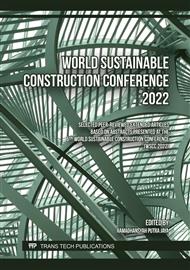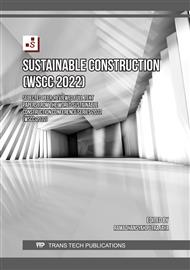[1]
S. Chandra Paul, "A Review on Reinforcement Corrosion Mechanism and Measurement Methods in Concrete," Civ. Eng. Res. J., vol. 5, no. 3, 2018.
DOI: 10.19080/cerj.2018.05.555661
Google Scholar
[2]
S. R. A. Saupi, M. A. Sulaiman, and M. N. Masri, "Effects of Soil Properties to Corrosion of Underground Pipelines: A Review," J. Trop. Resour. Sustain. Sci., vol. 3, no. May, p.14–18, 2015.
DOI: 10.47253/jtrss.v3i1.680
Google Scholar
[3]
D. Pawłowski and M. Szumigała, "Flexural Behaviour of Full-scale Basalt FRP RC Beams – Experimental and Numerical Studies," Procedia Eng., vol. 108, p.518–525, 2015.
DOI: 10.1016/j.proeng.2015.06.114
Google Scholar
[4]
I. Shakir Abbood, S. aldeen Odaa, K. F. Hasan, and M. A. Jasim, "Properties evaluation of fiber reinforced polymers and their constituent materials used in structures – A review," Mater. Today Proc., vol. 43, p.1003–1008, 2021.
DOI: 10.1016/j.matpr.2020.07.636
Google Scholar
[5]
J. Deng, M. M. K. Lee, B. Wan, and G. Amato, "Fibre Reinforced Polymer Composites for Structural Applications in Construction," Int. J. Polym. Sci., vol. 2017, p.1–1, 2017.
DOI: 10.1155/2017/9218529
Google Scholar
[6]
M. E. Gülsan, A. Mohammedameen, M. Sahmaran, A. Nis, R. Alzeebaree, and A. çevik, "Effects of sulphuric acid on mechanical and durability properties of ECC confined by FRP fabrics," Adv. Concr. Constr., vol. 6, no. 2, p.199–220, 2018.
Google Scholar
[7]
S. A. Hadigheh, R. J. Gravina, and S. T. Smith, "Effect of acid attack on FRP-to-concrete bonded interfaces," Constr. Build. Mater., vol. 152, p.285–303, Oct. 2017.
DOI: 10.1016/j.conbuildmat.2017.06.140
Google Scholar
[8]
K. Protchenko, F. Zayoud, M. Urbański, and E. Szmigiera, "Tensile and Shear Testing of Basalt Fiber Reinforced Polymer (BFRP) and Hybrid Basalt/Carbon Fiber Reinforced Polymer (HFRP) Bars," Materials (Basel)., vol. 13, no. 24, p.5839, Dec. 2020.
DOI: 10.3390/ma13245839
Google Scholar
[9]
K. F. Lim, "Negative pH does exist," J. Chem. Educ., vol. 83, no. 10, p.1465, 2006.
DOI: 10.1021/ed083p1465
Google Scholar
[10]
A. M. Taiwo, E. Ndububa, and O. O. Kolade, "Effect of Aqueous Solutions on Tensile Strength Characteristics of Commonly Used Steel Reinforcements in Nigeria," J. Archit. Environ. Struct. Eng. Res., vol. 2, no. 2, 2019.
DOI: 10.30564/jaeser.v2i2.680
Google Scholar
[11]
A. M. Alhozaimy, M. Ahmed, R. R. Hussain, and A. Al-Negheimish, "Quantitative non-linear effect of high ambient temperature on chloride threshold value for steel reinforcement corrosion in concrete under extreme boundary conditions," Materials (Basel)., vol. 14, no. 24, 2021.
DOI: 10.3390/ma14247595
Google Scholar
[12]
C. Wang, L. Sui, and J. Ou, "Experimental study on the corrosion resistance of GFRPP rebar in alkali, acid and salt solutions," Adv. Mater. Res., vol. 146–147, p.1356–1360, 2011.
DOI: 10.4028/www.scientific.net/AMR.146-147.1356
Google Scholar
[13]
G. Wu, Z.-Q. Dong, X. Wang, Y. Zhu, and Z.-S. Wu, "Prediction of Long-Term Performance and Durability of BFRP Bars under the Combined Effect of Sustained Load and Corrosive Solutions," J. Compos. Constr., vol. 19, no. 3, p.04014058, 2015.
DOI: 10.1061/(asce)cc.1943-5614.0000517
Google Scholar
[14]
M. Chowdhury and T. C. Turin, "Variable selection strategies and its importance in clinical prediction modelling," Fam Med Com Heal., vol. 8, p.262, 2020.
DOI: 10.1136/fmch-2019-000262
Google Scholar
[15]
B. W. Chong, R. Othman, P. J. Ramadhansyah, S. I. Doh, and X. Li, "Mathematical modelling of concrete compressive strength with waste tire rubber as fine aggregate," J. Mech. Eng. Sci., vol. 15, no. 3, p.8344–8355, 2021.
DOI: 10.15282/jmes.15.3.2021.12.0656
Google Scholar
[16]
Z. Wang et al., "Long-term durability of basalt- and glass-fibre reinforced polymer (BFRP/GFRP) bars in seawater and sea sand concrete environment," Constr. Build. Mater., vol. 139, no. May, p.467–489, 2017.
DOI: 10.1016/j.conbuildmat.2017.02.038
Google Scholar
[17]
T. Wu et al., "Enhancing effects of nahso3 on corrosion of t91 steel," J. Electrochem. Sci. Technol., vol. 11, no. 4, p.368–378, 2020.
DOI: 10.33961/JECST.2020.00997
Google Scholar



